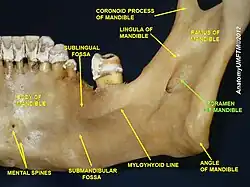Mandibular foramen
The mandibular foramen is an opening on the internal surface of the ramus of the mandible. It allows for divisions of the mandibular nerve and blood vessels to pass through.
| Mandibular foramen | |
|---|---|
 The mandibular foramen sits in the ramus of the mandible | |
 Mandible viewed from the inner side of the mandible, showing the mandibular foramen at left. | |
| Details | |
| Part of | mandible |
| System | skeletal |
| Identifiers | |
| Latin | foramen mandibulae |
| TA98 | A02.1.15.028 |
| TA2 | 865 |
| FMA | 53172 |
| Anatomical terms of bone | |
Structure
The mandibular foramen is an opening on the internal surface of the ramus of the mandible.[1][2] It allows for divisions of the mandibular nerve and blood vessels to pass through.[2]
Variation
There are two distinct anatomies to its rim.
- In the common form the rim is “V” shaped, with a groove separating the anterior and posterior parts.
- In the horizontal-oval form there is no groove, and the rim is horizontally oriented and oval in shape, the anterior and posterior parts connected.
Rarely, a bifid inferior alveolar nerve may be present, in which case a second mandibular foramen, more inferiorly placed, exists and can be detected by noting a doubled mandibular canal on a radiograph.[3]
Function
The mandibular nerve is one of three branches of the trigeminal nerve, and the only one having motor innervation. One branch of it, the inferior alveolar nerve, as well as the inferior alveolar artery, enter the foramen traveling through the body in the mandibular canal and exit at the mental foramen on the anterior mandible at which point the nerve is known as the mental nerve. These nerves provide sensory innervation to the lower teeth, as well as the lower lip and some skin on the lower face.[1]
Clinical significance
Local anaesthetic can be injected around the mandibular foramen to anaesthetise the mandibular nerve, and thereby the mandible the lower teeth on that side, and some skin on the lower face.[1]
Additional images
 View from behind of the mandibular foramina (red).
View from behind of the mandibular foramina (red).
References
- Campoy, Luis; Read, Matt (2015). "12 - Local and Regional Anesthetic Techniques". Handbook of Veterinary Pain Management (3rd ed.). Mosby. pp. 224–265. doi:10.1016/B978-0-323-08935-7.00012-0. ISBN 9780323089357.
- Doherty, Tom; Schumacher, James (2011). "15 - Dental restraint and anesthesia". Equine Dentistry (3rd ed.). Saunders. pp. 241–244. doi:10.1016/B978-0-7020-2980-6.00015-5. ISBN 978-0-7020-2980-6.
- Fehrenbach, Margaret; Herring, Susan (2011). Illustrated Anatomy of the Head and Neck (4th ed.). Saunders. p. 59. ISBN 9781455706303.
External links
- cranialnerves at The Anatomy Lesson by Wesley Norman (Georgetown University) (V)
- Nicholson, Michael L. (1985). "A study of the position of the mandibular foramen in the adult human mandible". The Anatomical Record. 212 (1): 110–2. doi:10.1002/ar.1092120116. PMID 4073538. S2CID 11785956.
- Hetson, George; Share, Jack; Frommer, Jack; Kronman, Joseph H. (1988). "Statistical evaluation of the position of the mandibular foramen". Oral Surgery, Oral Medicine, Oral Pathology. 65 (1): 32–4. doi:10.1016/0030-4220(88)90187-9. PMID 3422395.
- Smith, Fred H. (1978). "Evolutionary significance of the mandibular foramen area in neandertals". American Journal of Physical Anthropology. 48 (4): 523–31. doi:10.1002/ajpa.1330480412. PMID 96699.